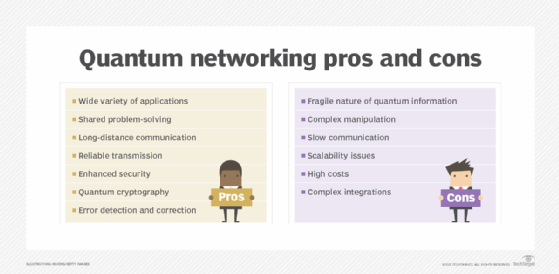The pros and cons of quantum networking
Quantum networking promises secure, high-speed communication -- someday. There are huge practical challenges, including fragility, cost and integration with traditional networks.
Quantum networking could be the future of high-speed business communication. Built on the principles of quantum physics, quantum networking theoretically can enable the exchange of ultra-secure, reliable and fast quantum bits -- or qubits -- for communication.
A quantum network infrastructure comprises multiple quantum processing units (QPUs) that exchange information in the form of qubits, the smallest units of quantum information, often called logical qubits. Quantum networking is the process of transmitting and receiving information encoded in qubits, which can exist in various states, within a quantum network.
Basic quantum networking technologies and encryption protocols exist, but commercialization is expected to take another decade. There are many pluses and minuses to consider, and it's important to draw a fine line between hypothetical scenarios and real-world use cases.
Benefits of quantum networking
A quantum network is built on a foundation of qubits, quantum processors and other quantum components, such as logic gates, switches, nodes and repeaters. Although it's still nascent, quantum networking could solve the problems of today's internet and offer several next-generation advantages.
Here are its main benefits.
Potential applications
In quantum networking, the entangled or superpositioned states of the qubits encode the information. Superposition refers to the ability of qubits to exist simultaneously in multiple states -- 0, 1 or both -- until they are measured. Entanglement is the linking of qubits, which enables parallelism and, thus, exponential increases in processing power as qubits are added.
Photon energy drives most quantum networking technologies. Its dual nature as both particle and wave enables a variety of quantum-related applications, including quantum sensing, quantum teleportation and quantum simulation, all of which are in initial stages of development and implementation.
However, experiments have verified that entanglement-based networks coupled with classical networking protocols can work over short distances.
Shared problem-solving
Ideally, quantum networks can deploy many nodes to solve a shared problem with high computational power and speed. Alice & Bob, a company working to develop a practical quantum computer, has reported some success using quantum nodes to generate communication requests.
Distributed quantum computing is a hypothetical quantum network cluster in which connected quantum processors provide high-speed computing and solve complex problems together. Within a decade, such quantum networking infrastructure could connect to the quantum internet to form quantum IoT that includes quantum processors, sensors, repeaters, controllers and other quantum devices.
Long-distance communication
Quantum entanglement was once only hypothetical, but experiments have confirmed the presence of quantum entanglement in photons, electrons and quarks over a short range of a few miles.
Two or more qubits in a state of entanglement exhibit the same or opposite spin, a type of movement of subatomic particles. If the state of one qubit changes upon measurement, the other qubit changes automatically.
Quantum entanglement has other properties that are important in networking. For example, it is sometimes called quantum teleportation because the actual qubits don't transfer over the channel to the router and other networking devices.
These properties are key to expanding the range of quantum networks. In addition, quantum repeaters, entanglement "swapping" and link-level entanglement generation are potential range-extending methods.
Reliable transmission
Quantum links generate entanglement between nodes. At the network layer, classical and quantum routing protocols come into play. The TCP/IP model used in classical networks describes the transmission of data packets over a network and acknowledgment by a receiver. In comparison, quantum networking eliminates the need for acknowledgment because it's possible to predict the intertwined states.
The transport layer of the network architecture ensures end-to-end delivery of qubit pairs. Quantum repeaters deployed at different locations along the network can enhance the reliability, computing power and range of quantum networks. They reduce the effects of qubit decoherence and signal loss to deliver accurate information.
Enhanced security
There is no doubt about security in quantum networking. The no-cloning theorem states that it is impossible to reproduce the quantum information of an unknown state onto another. That means a hacker, known as an eavesdropper, can't create a perfectly independent and identical copy of the unknown entangled quantum state.
However, a hacker could try to manipulate qubits in a quantum network to obtain a certain degree of replication. Quantum networking protocols can detect such manipulation on the channel and offer quantum error detection and correction capabilities to ensure high levels of security and prevent the eavesdropper from copying classified information.
Quantum cryptography
The application layer in quantum network architecture supports quantum cryptographic and computing protocols. Quantum networking incorporates quantum cryptography, based on the laws of physics, to cipher and decipher information. In quantum cryptography, Heisenberg's uncertainty principle states that it is impossible to measure the speed and position of a particle at the same time; this phenomenon helps maintain an ultra-secure connection. The sender and receiver compare measurements to eliminate the error, detect third-party attempts and decrypt the secret key.
Quantum cryptographic protocols include quantum key distribution (QKD), BB84, decoy-based QKD and more. Some quantum cryptographic protocols were developed in the 1990s and implemented in the early 2000s. QKD is used in real-world networks. It enables secret key sharing in the form of qubits, or polarized photons, over an insecure network.
Error detection and correction
Quantum networking can attain high accuracy by employing quantum error detection and correction algorithms. Many error correction algorithms, such as the Shor's, bosonic and bit flip algorithms, can detect deviations in the received qubit state by examining the transmitted photons. These protocols enable users to detect possible hacking attempts on the quantum network.
Interoperability
Quantum networks are interoperable with classical networks. In addition, hybrid quantum network architectures use classical routing protocols and congestion control methods to maintain entanglement stability. Research organizations and a few businesses have reported deploying entanglement-based networks, and research in low-cost, fully operational and stable hybrid quantum networks continues.

Challenges of quantum networking
Despite its benefits, quantum networking isn't without challenges and technological barriers. The main disadvantage of quantum networking is the lack of practical implementations. Only a few hundred organizations are developing or using any type of quantum technology.
Here are specific disadvantages of quantum networking.
Memory decoherence
Quantum information is fragile in nature, making it susceptible to environmental factors, such as quantum interference, decoherence and signal loss. The longer a qubit stays in an environment, the more likely it will suffer from transmission loss and memory loss, which in turn reduce data integrity. One fix available to network administrators is to deploy quantum repeaters to try to maintain accuracy.
Poor results
Designing the network architecture of a quantum network is challenging. The no-cloning theorem might be a reliable safeguard against copies, but it also eliminates the possibility of signal duplication and amplification. The overall effect is that quantum networks are prone to information loss and limited ranges of only a few miles.
Complex manipulation
The presence of an observer collapses the wave function of quantum states. Measuring the state of a qubit alters its state, making it difficult to maintain data integrity. From a business perspective, the inability to copy the quantum state could limit the availability of useful applications. The use of quantum logic gates to manipulate quantum information between nodes enables transmission, but the gates can't violate the no-cloning theorem prohibition against copies.
Slow communication
Quantum networking is a futuristic concept, even given the development going on across the globe. A common misconception is that quantum communication is faster than the speed of light. The reality is quantum networking often uses conventional communication methods that eliminate the possibility of faster-than-the-speed-of-light communication. And like the traditional internet, quantum networking uses optical fiber for communication.
Scalability issues
Long-distance quantum communication remains hypothetical because quantum networks separate nodes over short distances of a few miles. They also typically have fewer processors than classical networks. In addition, current QPUs generate fewer qubits than the bits generated in classical networks, and maintaining coherence over a large number of qubits is practically impossible.
High cost
Implementing and maintaining quantum networks requires a big investment in hardware and software alike. The specialized quantum hardware requires extremely cold cryogenic environments that add energy and maintenance costs. That's why big-budget industries, such as governments, deep-space research and cryptographic projects, are best suited to pursue quantum networking. SMBs can't get access to quantum networking facilities, which limits the chances of large-scale deployment.
Complex integration
Although quantum and classical networks work together, quantum networking has its own, still-evolving standardization and interoperability efforts for enabling hybrid networks. To integrate with the classical internet, a network must deploy a large number of QPUs. Moreover, the TCP/IP communication models of classical networks and quantum networking work on different technologies, and it's difficult to combine them.
The future of quantum networking
Large businesses and organizations are interested in using quantum networking to enable optimized computing and fast communication to address complex problems that likely can't be solved with classical computing alone. Because quantum networking is such a new networking technology, it can be a challenge for providers to commercialize it.
It could take decades for quantum networks to operate commercially at the affordable prices of today's networks. Nevertheless, over the next few years, sectors such as information technology, space, research and healthcare could begin to use quantum networks for fast communication and high-performance computing.
Venus Kohli is an engineer turned technical content writer, having completed a degree in electronics and telecommunication at Mumbai University in 2019. Kohli writes for various tech and media companies on topics related to semiconductors, electronics, networking, programming, quantum physics and more.







